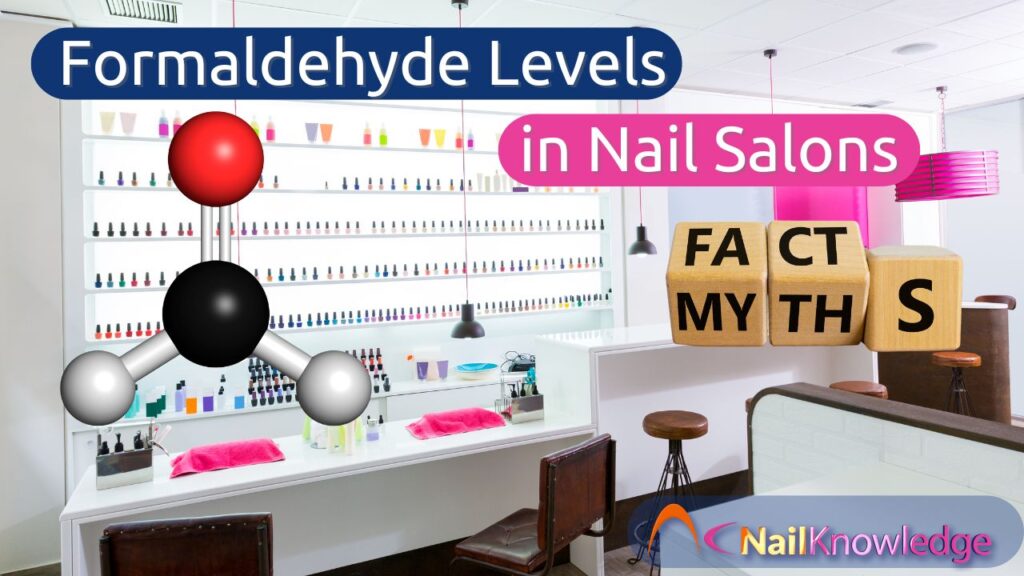Formaldehyde is a naturally occurring chemical compound found in many everyday environments. While it has gained a negative reputation, particularly in the beauty industry, it’s important to distinguish between fear-based misinformation and scientific facts. In nail salons, concerns about formaldehyde levels are often based on misconceptions. This article explores the truth behind formaldehyde use in nail products and clarifies whether it poses any genuine risk to nail professionals or clients.
¿Son peligrosos los niveles de formaldehído en los salones de manicura?
No, formaldehyde is not a problem in nail salons and never has been. The so-called risk of formaldehyde in nail polish campaigns was designed to mislead consumers, not to inform them. Here’s why I say this: a multi-year independent scientific study was performed under the guidance of the California State Attorney General with the goal of measuring formaldehyde levels in salons.
Niveles de formaldehído en los salones de peluquería
Se analizaron salones de muchos tamaños y tipos, tanto en el norte como en el sur de California, y durante el invierno y el verano, razón por la cual se tardó más de un año en completarlo. El estudio demostró de forma concluyente que los niveles de formaldehído en los salones de manicura no difieren de los que cabría esperar en otros lugares de trabajo comunes en los que no se utilizan productos para las uñas. Curiosamente, durante el estudio se observó que los niveles de formaldehído eran más altos por la mañana, cuando el salón abría por primera vez, y luego disminuían de forma constante a lo largo de la mañana, estabilizándose en sus niveles normalmente bajos por la tarde.
Por qué el formaldehído puede acumularse de la noche a la mañana
When the salon was closed for the night, traces of formaldehyde gas can build up as they normally do in closed spaces. Traces slowly escape from carpet glue and building materials, such as plywood. When a salon is opened and the air begins to circulate, the formaldehyde levels drop back down to normal levels. Even so, all the measured air concentrations in the nail salon study were considered safe.
Conclusiones oficiales sobre la seguridad en los salones de manicura
Cuando concluyó el estudio y se publicó el informe final, las autoridades gubernamentales de California dictaminaron que, sobre la base de los amplios datos de exposición de los salones de manicura, cualquier nivel de formaldehído en los salones procedente de esmaltes, tratamientos y endurecedores de uñas era tan bajos que no se requieren advertencias a los consumidores. En otras palabras, el esmalte de uñas no libera gas formaldehído en el aire para crear ningún riesgo para la salud, incluso bajo lo que es probablemente la regulación más estricta de formaldehído en el mundo.
Conceptos erróneos sobre el formaldehído en los productos para las uñas
This is because nail polish has never contained formaldehyde gas as an ingredient. Fear-based advocacy groups have tricked consumers into thinking that it does, but it’s just a big deception intended to frighten your friends, family, and customers to get them to donate money. Any gases in nail polish could only exist in very tiny traces, e.g., 0.0001% or a ten-thousandth of a percent!
Resina de formaldehído de tosilamida
Some confuse a hard polymer resin called tosylamide formaldehyde resin, thinking this solid polymer is the same as formaldehyde gas. It’s not even close. It can be a source of traces of formaldehyde dissolved in solution, but these are very safe levels and will not cause harm. Some claim these are dangerous because they release formaldehyde – well, so do people. We naturally exhale traces of formaldehyde in our breath because our bodies naturally make and use formaldehyde on a daily basis.
El formaldehído como posible alergeno
While the levels of formaldehyde found in salons are generally considered low and safe, it’s important to acknowledge that formaldehyde is a known sensitiser and allergen for some individuals. Prolonged or repeated exposure, even at low levels, can trigger allergic contact dermatitis, particularly in those with existing sensitivities. Symptoms may include redness, itching, or rash, especially on the hands and fingers. For this reason, professionals who experience skin reactions should consult a healthcare provider and consider using gloves or alternative products that are free from formaldehyde-releasing compounds.
Aclaración de los niveles de metilenglicol y formaldehído
Some nail hardeners contain “methylene glycol” at around 1-2%. In the past, manufacturers were required to call this ingredient by the incorrect name, “formaldehyde,” rather than its correct name, “methylene glycol.” This error has since been corrected, but it’s probably where the confusion began. Even when informed of their error, some advocacy groups continued to ignore the facts and spread misinformation.
Desacreditar la información errónea sobre los niveles de formaldehído
These groups claimed that up to 5% formaldehyde was used in nail polish, which was another huge distortion. When methylene glycol is used as a nail hardener, usually at 2% or less, the container typically contains less than 0.001% dissolved formaldehyde gas – not nearly enough to cause any harm. Even if all the formaldehyde suddenly came out at once, it still wouldn’t be harmful. Our bodies naturally exhale formaldehyde with every breath, and it’s even found in some organic foods like apples.
Niveles seguros de formaldehído en los salones de manicura
Formaldehyde is not the terrible boogeyman these irresponsible groups claim it to be. The claim that there are no safe levels of formaldehyde is simply not true. Formaldehyde does not absorb through the skin or nails, as some falsely claim. It only poses an inhalation risk at high concentrations over long periods – levels that would never be reached in a nail salon.
Conclusión: Confíe en los hechos sobre los niveles de formaldehído
Clearly, nail professionals are not exposed to significant amounts of formaldehyde gas, nor is there any risk of harm from the tiny traces found in salons or nail polish. Nail salons do not need to monitor formaldehyde levels because the risk is negligible. Don’t let fear-based groups mislead you – nail polish has been safe for over 80 years, and there’s no evidence to suggest otherwise.


